
Mollusks are a phylum of invertebrate animals defined by their distinct body structure -- a head, a visceral mass, a mantle and some kind of foot. The mantle protects the mollusk's body in place of a skeletal structure, and the "foot" has taken on many adaptions across the mollusca species.
What Are Invertebrates?
Invertebrates are animals that don't have a spine. Animals that have spines are called vertebrates. Humans and other mammals are vertebrates, along with fish, birds, reptiles and amphibians, for example. Invertebrates include animals such as insects, arachnids, crustaceans and worms. The invertebrate group of animals includes millions of species; in fact, 95 percent of the identified animal species on Earth are invertebrates.
What Defines a Mollusk?

More than 50,000 species of mollusk exist. Mollusks are invertebrates that have a mantle -- a body structure that excretes a shell or protective coating for the animal. Mollusks are grouped into seven taxonomical classifications: Aplacophora, Monoplacophora, Scaphapoda, Bivalvia, Cephalopoda, Gastropoda and Polyplacophora.
Aplacophora, Monoplacophlora and Scaphapoda
The Monoplacophora, Aplacophora and Scaphapoda varieties are some of the most seldom seen mollusks, either because they live in very deep ocean waters or because few species have been discovered. The Aplacophora species are numerous but difficult to study because they live in the deep ocean floor. About 300 Aplacophora species are recorded. This class of mollusks is made up of small, shell-less, wormlike creatures. Only 11 species of Monoplacophora are known, and they all live in the deep ocean. Their name means "one shell." They resemble limpets. More than 900 species of Scaphopods have been recorded. They are called tusk shells, because of their long, thin shape and hard outer shells. They are small creatures, usually 3 to 6 inches long, that spend their time burrowed in the ocean substrate.
Bivalves

Clams, limpets, mussels, oysters and scallops are the most common types of bivalves, which also are mollusks. Bivalve means "two shells," which is what these creatures have instead of a bone structure. Bivalves are filter feeders. Most spend their lives anchored to one spot; they often live in large colonies. Bivalves range from tiny dime-size mussels to giant clams that can weigh hundreds of pounds.
Cephalopods

The most common cephalopods are squids, octopuses, cuttlefish and nautiluses. Nautiluses are the only cephalopods that have a shell. Squids have eight arms and two long tentacles. Octopuses have eight arms of equal length. Squid and cuttlefish have one long bone in their body, called the cuttlebone; octopuses have no bones at all.
Gastropods

About 70 percent of mollusk species are gastropods. Common gastropods include snails, abalones, sea cucumbers and slugs. They all move by rippling the muscles in their "stomach foot," which is what gastropod means. Gastropods got their name because their "foot" is on the underside of their visceral mass, the part of the body that houses the organs. Many but not all gastropods have a shell to protect their soft bodies.
Polyplacophora
Polyplacophora means "many plated shell" and refers to the class of prehistoric-looking mollusks that live on rocks and eat algae. Chitons are the most common polyplacophora. They are extremely slow-moving creatures -- a chiton may move only 10 feet in a year. They range in size from less than an inch to several inches long.
References
Resources
Photo Credits
-
Nautilus Floating in Tank image by Lucid_Exposure from Fotolia.com
Writer Bio
Madeline Masters works as a dog walker and professional writer. In the past she has worked as a fitness columnist, fundraising copywriter and news reporter. Masters won two Pennsylvania Newspaper Association Awards in 2009. She graduated from Elizabethtown College with a Bachelor of Arts in English.


